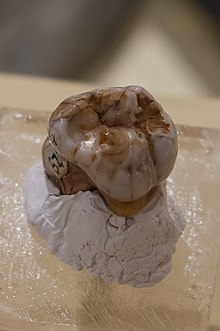
Back Denisova-hominien Afrikaans دينيسوفان Arabic Homínidu de Denísova AST دنیسووا اینسانی AZB Дзянісаўскі чалавек Byelorussian Денисов човек Bulgarian দেনিসোভা মানব Bengali/Bangla Denisovski hominin BS Hominins de Deníssova Catalan مرۆڤی دێنیسۆڤان CKB

The Denisovans or Denisova hominins ( /dɪˈniːsəvə/ di-NEE-sə-və) are an extinct species or subspecies of archaic human that ranged across Asia during the Lower and Middle Paleolithic, and lived, based on current evidence, from 285 to 25 thousand years ago.[1] Denisovans are known from few physical remains; consequently, most of what is known about them comes from DNA evidence. No formal species name has been established pending more complete fossil material.
The first identification of a Denisovan individual occurred in 2010, based on mitochondrial DNA (mtDNA) extracted from a juvenile female finger bone excavated from the Siberian Denisova Cave in the Altai Mountains in 2008.[2] Nuclear DNA indicates close affinities with Neanderthals. The cave was also periodically inhabited by Neanderthals, but it is unclear whether Neanderthals and Denisovans ever cohabited in the cave. Additional specimens from Denisova Cave were subsequently identified, as was a single specimen from the Baishiya Karst Cave on the Tibetan Plateau, and Cobra Cave in the Annamite Mountains of Laos. DNA evidence suggests they had dark skin, eyes, and hair, and had a Neanderthal-like build and facial features. However, they had larger molars which are reminiscent of Middle to Late Pleistocene archaic humans and australopithecines.
Denisovans apparently interbred with modern humans, with a high percentage (roughly 5%) occurring in Melanesians, Aboriginal Australians, and Filipino Negritos. This distribution suggests that there were Denisovan populations across Asia. There is also evidence of interbreeding with the Altai Neanderthal population, with about 17% of the Denisovan genome from Denisova Cave deriving from them. A first-generation hybrid nicknamed "Denny" was discovered with a Denisovan father and a Neanderthal mother. Additionally, 4% of the Denisovan genome comes from an unknown archaic human species, which diverged from modern humans over one million years ago.
- ^ Zimmer, Carl (2 March 2024). "On the Trail of the Denisovans - DNA has shown that the extinct humans thrived around the world, from chilly Siberia to high-altitude Tibet — perhaps even in the Pacific islands". The New York Times. Archived from the original on 2 March 2024. Retrieved 2 March 2024.
- ^ Cite error: The named reference
Pääbo et al.was invoked but never defined (see the help page).
© MMXXIII Rich X Search. We shall prevail. All rights reserved. Rich X Search